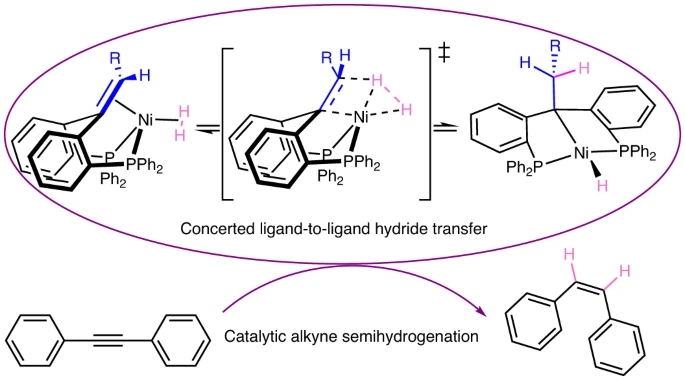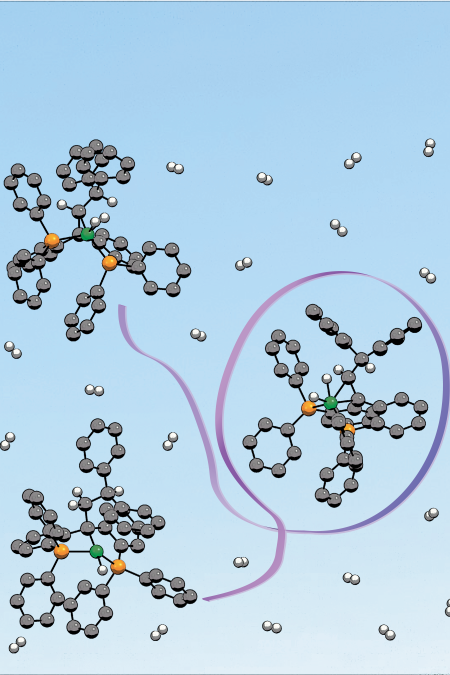博文
乌得勒支化学家发现了设计更可持续的分子催化剂的机制
||
乌得勒支化学家发现了设计更可持续的分子催化剂的机制
诸平
据荷兰乌得勒支大学(Utrecht University, Utrecht, Netherlands)2023年12月18日提供的消息,乌得勒支的科学家们,在马克-艾蒂安·莫雷特(Marc-Etienne Moret)的指导下,发现了一种构建分子催化剂的新机制(Utrecht chemists discover mechanism to design more sustainable molecular catalysts)。这种新机制涉及到地球上丰富的金属镍,而不是通常用作分子催化剂的贵金属。马克-艾蒂安·莫雷特指出:“这一发现开启了一个新的研究领域,为设计更可持续的催化剂带来了一个全新的概念。”
2017年,化学研究员马克-艾蒂安·莫雷特获得了欧洲研究委员会(European Research Council简称ERC)启动资助(Marc-Etienne Moret received an ERC Starting Grant ),用于研究性能更好的新型催化剂。现在,随着这一发现2023年12月5日发表在科学杂志《自然化学》(Nature Chemistry)上{详见María L. G. Sansores-Paredes, Martin Lutz, Marc-Etienne Moret. Cooperative H2 activation at a nickel(0)–olefin centre. Nature Chemistry, 2023. DOI: 10.1038/s41557-023-01380-1. Published: 05 December 2023. https://www.nature.com/articles/s41557-023-01380-1},他的团队朝着他当时设定的目标迈出了一大步:开发一种基于非贵金属的新型催化剂。
马克-艾蒂安·莫雷特热情地说:“我们发现了一种新的反应机制,这种情况并不经常发生,尤其是在一个被研究得如此彻底的领域。我们非常渴望追求这个新的研究方向。”
药品和色素(Pharmaceuticals and colour pigments)
马克-艾蒂安·莫雷特等人发现了一种新的,更可持续的激活氢的机制。活化氢是分子催化剂发展的重要一步,它有助于精细化学品的合成,如药品和色素。通常,氢的活化需要一种贵金属,如铑(rhodium, Rh)、铱(iridium, Ir)或钌(ruthenium, Ru)。这些金属是有效的,但也昂贵,稀缺,并可能对环境有害。马克-艾蒂安·莫雷特的研究小组发现了一种用地球上丰富的元素镍激活氢的新机制。
量身定制的分子(Tailormade molecule)
为了通过这种新方法激活氢,马克-艾蒂安·莫雷特团队使用了一种围绕金属镍的定制分子。这种特殊类型的分子被称为钳形配体(pincer ligand),包括烯烃(olefin),这是一种有机化合物,在两个碳原子之间含有双键。研究人员通过光谱学观察到,氢不是直接附着在金属镍上,而是一种称为配体到配体的氢转移过程:氢直接从附着在金属镍上的氢分子转移到烯烃分子上。“我们可以直接看到两种形式的催化剂,一种是完整的氢分子与金属结合,另一种是氢分子在镍和碳原子上分裂,”马克-艾蒂安·莫雷特解释说。此外,计算机模型预测了连接这两种可观测形态的过渡态的存在。
未来如何?(What’s next?)
马克-艾蒂安·莫雷特将继续探索利用新发现的机制可以做些什么。也许它可以应用于其他金属,或者其他化学键。事实上,就在这篇论文被审查的时候,马克-艾蒂安·莫雷特的团队证明了这种新机制可以应用于碳氢键,这是他特别兴奋的事情。“有机分子有很多碳氢键。所以,如果我们设法将这种新机制应用到这些键上,精细化学品的合成最终将会快得多。我非常渴望追求这个新的研究方向。”
该项目获得了欧洲研究委员会(ERC)在欧盟“地平线2020”研究和创新计划下的资助{European Research Council (ERC) under the European Union’s Horizon 2020 research and innovation program (grant agreement no. 715060) }。该X射线衍射仪由荷兰科学研究组织(Netherlands Organization for Scientific Research简称NWO)资助。
上述介绍,仅供参考。欲了解更多信息,敬请注意浏览原文或者相关报道。
Catalytic olefin hydrogenation is ubiquitous in organic synthesis. In most proposed homogeneous catalytic cycles, reactive M–H bonds are generated either by oxidative addition of H2 to a metal centre or by deprotonation of a non-classical metal dihydrogen (M–H2) intermediate. Here we provide evidence for an alternative H2-activation mechanism that instead involves direct ligand-to-ligand hydrogen transfer (LLHT) from a metal-bound H2 molecule to a metal-coordinated olefin. An unusual pincer ligand that features two phosphine ligands and a central olefin supports the formation of a non-classical Ni–H2 complex and the Ni(alkyl)(hydrido) product of LLHT, in rapid equilibrium with dissolved H2. The usefulness of this cooperative H2-activation mechanism for catalysis is demonstrated in the semihydrogenation of diphenylacetylene. Experimental and computational mechanistic investigations support the central role of LLHT for H2 activation and catalytic semihydrogenation. The product distribution obtained is largely determined by the competition between (E)–(Z) isomerization and catalyst degradation by self-hydrogenation.

https://blog.sciencenet.cn/blog-212210-1414540.html
上一篇:精准医学:癌症治疗的新时代
下一篇:发现可能治疗ER+乳腺癌的候选药物
